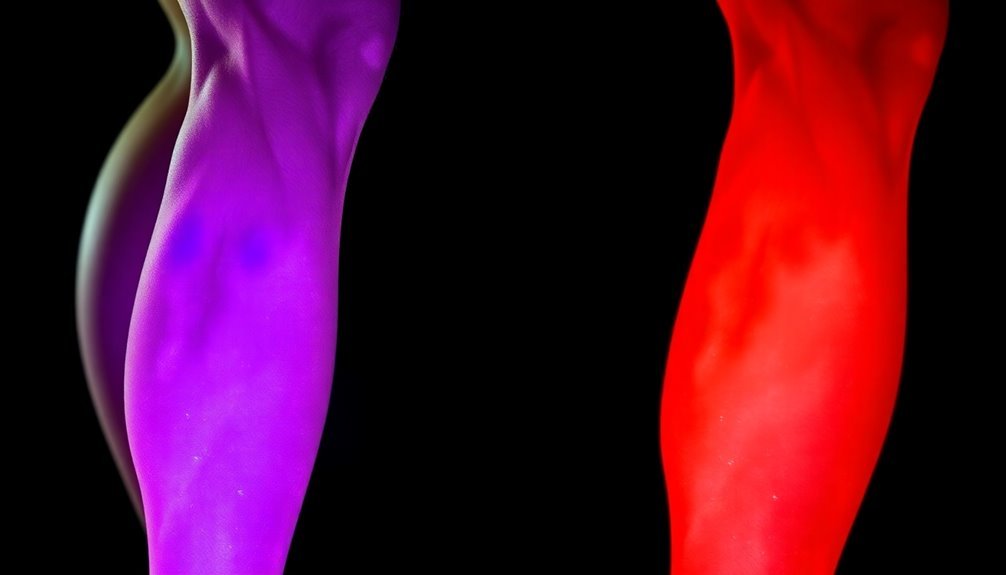Near-infrared light therapy will supercharge your recovery through three powerful benefits. First, it stimulates your cells' ATP production, giving them more energy to repair and regenerate. Second, it enhances your blood flow from 5-7 quarts per minute to 13 quarts per minute, delivering essential oxygen and nutrients while removing waste products. Third, it accelerates tissue repair by up to 40% faster for musculoskeletal injuries and 50% quicker for surface wounds. These benefits work together to reduce pain, decrease inflammation, and speed up healing. Let's explore how you can maximize these recovery-boosting effects.
Optimized Cellular Energy Production

Through the remarkable interaction with cytochrome c oxidase, near-infrared light therapy revolutionizes cellular energy production. When you undergo this therapy, near-infrared light penetrates your tissues and stimulates cytochrome c oxidase, triggering a cascade of beneficial cellular responses that boost your ATP production.
You'll experience enhanced mitochondrial efficiency as the near-infrared light optimizes your electron transport chain activity. This process increases oxygen utilization in your mitochondria while simultaneously removing a key inhibitor – nitric oxide – through photodissociation. Studies have shown that oxidative phosphorylation efficiency is 15 times greater than anaerobic glycolysis.
As a result, your cells can produce energy more efficiently with less oxidative stress. The improved ATP synthesis directly impacts your cellular function and recovery. You'll benefit from reduced production of harmful reactive oxygen species, while your cells gain access to more readily available energy.
This enhanced energy production supports essential processes like protein synthesis and cellular repair mechanisms. What's particularly notable is that you won't just experience temporary benefits – the therapy's effects on your mitochondrial function lead to sustained improvements in cellular energy production, making it an effective tool for ongoing recovery and performance enhancement.
Enhanced Blood Flow Benefits
Near-infrared light therapy delivers powerful circulatory benefits by triggering significant increases in blood flow throughout your body.
Clinical studies demonstrate that regular infrared sessions can effectively lower blood pressure and promote better circulation over time.
When you undergo this therapy, your blood flow can increase from 5-7 quarts per minute to an impressive 13 quarts per minute, similar to what you'd experience during exercise.
The therapy works by stimulating nitric oxide production, which acts as a natural vasodilator, widening your blood vessels and capillaries instantly.
This enhanced circulation guarantees your muscles and joints receive more oxygen and nutrients while efficiently removing metabolic waste products like lactic acid.
You'll benefit from the deep penetrating properties of near-infrared light, which reaches far beneath your skin's surface to promote healing at the cellular level.
This penetration is essential for effective muscle recovery and pain reduction, as it targets inflammation directly at its source.
For athletes and active individuals, these circulatory improvements translate into faster recovery times and reduced muscle soreness.
Your body's enhanced blood flow helps repair tissue damage more efficiently, while the increased cardiac output provides a gentle cardiovascular conditioning effect, supporting your overall fitness goals.
Accelerated Tissue Repair

Tissue repair takes a quantum leap forward with near-infrared light therapy's ability to supercharge your cells. By stimulating your mitochondria, this therapy boosts ATP production, giving your cells the energy they need to repair and regenerate faster.
You'll experience enhanced healing across multiple tissue types, from muscles and tendons to ligaments and cartilage. The combination of NIR with red light and SoftWave therapy delivers superior clinical outcomes for optimal tissue regeneration.
When you're dealing with injuries or recovering from surgery, near-infrared light penetrates deep into your tissues, triggering collagen production and reducing inflammation. This combination accelerates your healing process, with studies showing up to 40% faster recovery for musculoskeletal injuries and 50% quicker healing for lacerations.
- Your muscle strains and tendinitis heal more rapidly through enhanced cellular repair and reduced inflammation.
- Your ligament injuries recover faster due to increased collagen production and improved blood flow.
- Your post-surgical recovery time decreases as the therapy reduces pain and swelling.
Whether you're an athlete looking to bounce back from training or recovering from an injury, near-infrared light therapy's tissue repair benefits can greatly reduce your downtime.
The therapy's effects are particularly powerful when combined with red light, offering sustained healing that can last for months.
Frequently Asked Questions
How Long Should Each Near-Infrared Therapy Session Last for Optimal Results?
You'll want to start with 5-10 minute sessions and gradually increase to 15-30 minutes, depending on your target area. Keep thinner skin treatments shorter and allow longer exposure for deeper tissue areas.
Can Near-Infrared Therapy Be Used While Taking Medications or Supplements?
You'll need to check your medications carefully, as some are contraindicated with near-infrared therapy. Wait 5 days after stopping certain medications, and always consult your healthcare provider before starting treatment.
Are There Any Side Effects Associated With Regular Near-Infrared Light Therapy?
You may experience mild side effects like temporary pain, skin irritation, or headaches. It's important to wear eye protection and start with short sessions. Some medications can increase your photosensitivity risk.
What's the Recommended Distance Between the Device and Treatment Area?
You'll want to position your near-infrared device 6-12 inches from your treatment area. This ideal distance guarantees effective light penetration while preventing skin irritation. Always check your device's specific manufacturer guidelines.
How Soon After Exercise Should Near-Infrared Therapy Be Applied?
You should apply near-infrared therapy within 10-15 minutes after your workout for ideal benefits. Starting treatment immediately after exercise will help reduce muscle soreness, decrease inflammation, and speed up your recovery process.
In Summary
You'll experience powerful healing effects when you harness near-infrared light therapy for recovery. As it optimizes your cellular energy, enhances blood circulation, and speeds up tissue repair, you're giving your body the tools it needs to bounce back faster. Whether you're an athlete or simply looking to heal, incorporating near-infrared therapy into your routine can transform your recovery process.





Leave a Reply